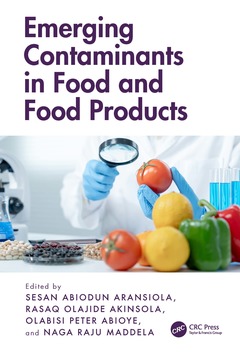Emerging Contaminants in Food and Food Products
Coordonnateurs : Aransiola Sesan Abiodun, Akinsola Rasaq Olajide, Abioye Olabisi Peter, Maddela Naga Raju

In the recent years, a wide variety of new chemicals continue to be developed as a result of industrial development and associated anthropogenic activities. The microbial contaminants in the environment, more precisely, antibiotic-resistant genes/bacteria produced as a result of mutation due to antibacterial drugs, are also considered emerging contaminants and specifically called emerging microbial contaminants such as sapoviruses, Waddlia chondrophila and Streptococcus parauberis. Pharmaceuticals and Personal Care products are a diverse group of compounds that includes ibuprofen, diclofenac, triclosan, antibiotics, anti-inflammatory agents, steroidal hormones, and active ingredients in soaps, detergents and perfumes which could find their way into food materials are tagged emerging contaminants.
Given this, Emerging Contaminants in Food and Food Products discusses issues around the emerging contaminants in food and food products. Different types of contaminants, such as biological, chemical, organic, inorganic and microbial contaminants in foods, ways of detecting them and regulations surrounding global food safety are all covered.
Features
· Discusses all the categories of contaminants in food and food products. Biological, chemical, organic, inorganic, and microbial contaminants
· Provides full information on emerging food contaminants, their effect on human and animal heath, and how it affects global food security and emerging technological applications in solving global problem.
· Gives detection and prevention strategies and guideline policies on emerging contaminants of foods
· Bring into account global perspectives on food contaminants and health implications.
Also, this volume will serve as an information hub of emerging contaminants for scientists/researchers and professionals globally. This book is a good collection of independent chapters which presents full insights in the study of emerging contamination in food and the effects of these contaminants in humans and animals.
Section 1: Introduction to Emerging Contaminants (ECs) in Foods. Chapter 1. Emerging Contaminants in Foods: Types, Sources and Effects. Chapter 2. Soil-Plant Interaction in Heavy Metal Uptake and Crop Quality. Chapter 3. International Regulations in Food Contaminants. Chapter 4. Emerging Organic Contaminants in Drinking Water: Global Perspectives. Section 2: Food Emerging Contaminants and Food Insecurity. Chapter 5. Biological and Chemical Food Contaminants: Challenges and Solutions. Chapter 6. Emerging Microbial Food Contaminants: Types, Effects and Detection. Chapter 7. Cases of Micro and Nanoplastics in Food and Food Products. Chapter 8. Emerging Contaminants from Pesticides, Biosolids and Manure in Agricultural Food Production: Health and Environmental Implications. Chapter 9. Effects of Emerging Pharmaceutical Contaminants on Human. Section 3: Application of Emerging Technology in Food Contaminants Mitigation. Chapter 10. Natural Contaminants in Infant Foods: Case Study. Chapter 11. Effects of Biodegradation and Biotransformation of Perflourinated Compounds (PFCs), Polybrominated Diphenyl Ethers (PBDEs) and Perflouroalkyl Substances (PFASs) in Human Foods and Foods Products. Chapter 12. Detection of Microbial Food Contaminants Using Functionalized Nanomaterials and Metal-organic Frameworks (MOFs). Chapter 13. Distribution, Prevention and Control of Emerging Food Contaminations. Chapter 14. Heavy metals and emerging contaminants in foods associated with neurotoxicity in human. Chapter 15. Current Trends and Future Research in Emerging Food Contaminants.
Sesan Abiodun Aransiola is a Ph.D holder in Environmental Microbiology in the Department of Microbiology, Federal University of Technology, Minna, Nigeria. He obtained his first degree (B.Tech) and Master Degree (M.Tech) from the same department in 2009 and 2014 respectively. He has demonstrated his research expert in the production of vermicasts from vermicoposting (Vermitechnology) of organic wastes to assist plants in the remediation of polluted soil with heavy metals. Currently, he is a Lecturer at the Department of Microbiology, University of Abuja, Nigeria. His area of interest is Environmental Microbiology with research area in phytoremediation, vermicomposting, biosorption and bioremediation of soil contaminated environment. He is an award winning researcher and has over 70 publications including book chapters, research and review articles of good international repute with high impact factors. He has co-edited scientific books of global interest which include microbial biotechnology for bioenergy (Elsevier). Ecological interplays in microbial enzymology, vermitechnology: economic, environmental and agricultural sustainability, prospects for soil regeneration and its impact on environmental protection (Springer). Microbial biofilms – applications and control, marine greens: environmental, agricultural, industrial and biomedical applications (CRC Press) with many more in the process. Also, he worked to the rank of an assistant chief scientific officer at Bioresources Development Centre, National Biotechnology Development Agency, Nigeria where he was involved in the uses of vinasse (a by-product of ethanol) as bio-fertilizer to reclaim polluted soil for agricultural purposes. Abiodun is a member of Nigerian Society for Microbiology and American Society for Microbiology.
Rasaq Olajide Akinsola is a postdoctoral scientist training under the T-32 prostate cancer program at the Department of Medicine, the division of Haematolog
Date de parution : 08-2024
17.8x25.4 cm
Thèmes d’Emerging Contaminants in Food and Food Products :
Mots-clés :
phthalates; parabens; environmental pollution; Food Products; Organic; Chemicals; Food contaminants



